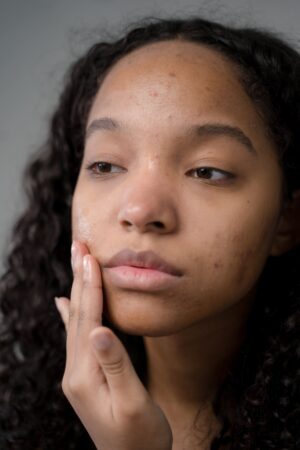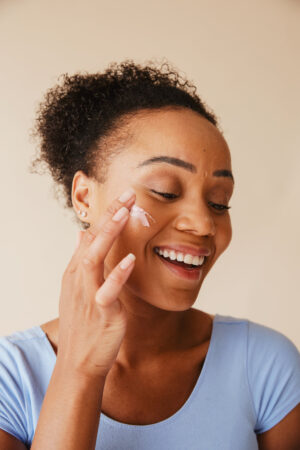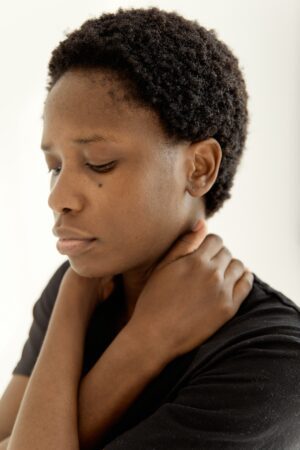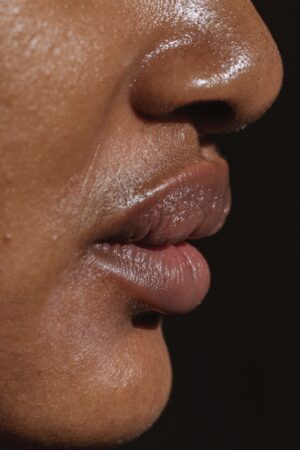Conditions
We specialise in managing common yet challenging skin conditions, working closely with you to develop an effective, results-driven treatment plan tailored to your unique needs.

Acne is a common inflammatory skin condition which causes spots. It affects most people at some point in their lives. It is triggered by multiple factors, including excess oil production, dead skin cells accumulate in your pores, bacteria build up and inflammation. It can also be influenced by a number of health and lifestyle factors, such as stress and hormonal changes. Acne can be found on your face neck and back and can be in the form of simple pimples that are sore and painful, pus-filled, whiteheads, blackheads and cystic – deep rooted nodules.
Treatments for acne: Book a consultation for more info

Acne scars are a common complication of acne, resulting from the skin producing excess collagen during the healing process or experiencing a loss of collagen. Any type of acne spot can cause scarring, but it is more prevalent with cystic acne. Picking or squeezing spots can exacerbate scarring, so it’s crucial to avoid this behaviour.
There are four main types of acne scars:
- Ice pick scars – Small, deep holes resembling punctures from a sharp needle, creating a pinprick appearance on the skin’s surface.
- Rolling scars –Broad depressions with rolling or sloping edges, giving the skin an uneven, wavy texture.
- Boxcar scars – Round or oval depressions with well-defined edges, similar to craters, creating a pitted appearance.
- Hypertrophic/keloid scars – Raised scars caused by excess collagen deposition. Hypertrophic scars remain within the borders of the original acne lesion, while keloid scars extend beyond these borders.
Preventing acne scars involves proper acne management and avoiding the temptation to pick or squeeze spots.
Treatments for acne scars: Book a consultation for more info

Textured skin refers to an uneven skin surface characterised by irregularities such as bumps, rough patches, and enlarged pores. It often results from acne scars, other types of scars, or accumulated dead skin cells. Additionally, factors like rough, dull skin or enlarged pores can contribute to a lack of smoothness and an uneven appearance. Proper skincare and treatments can help improve the texture and restore a smoother, more radiant complexion.
Treatments for textured skin: Book a consultation for more info

Our skin’s natural colour is determined by the amount of melanin, a pigment that ranges from brown to black to red to yellow, depending on genetic makeup. Hyperpigmentation occurs when excess melanin deposits on the skin’s surface, leading to localised or patchy areas of uneven skin tone. This condition is common, especially in skin of colour, and can be triggered by various external factors or underlying skin conditions.
Causes of hyperpigmentation include post-inflammatory hyperpigmentation from injuries and inflammatory conditions such as acne, as well as inflammation from bites and scratches. Other causes include sunspots or age spots resulting from sun damage, and melasma.
Treatments for hyperpigmentation: Book a consultation for more info

Melasma is a common cause of hyperpigmentation, characterized by excess melanin on the forehead, nose, cheeks, or chin, resulting in brown or greyish patches of mottled pigmentation on the skin’s surface. The exact cause of melasma is unknown, but it is believed to have a strong genetic predisposition and can be triggered by hormonal changes and UV (sunlight) exposure. It is most noticeable in the summer and often improves in the winter.
Treatments for melasma: Book a consultation for more info

Excessively dry skin can result from underlying conditions such as eczema, using inappropriate cosmetic products, or your genetic skin type. This condition often makes the skin feel tight, itchy, and highly sensitive to cosmetic products. The dryness is usually due to a lack of naturally occurring fats in the skin, known as lipids, particularly ceramides, which are the most abundant type of lipid and are often depleted in dry skin.
Treatments for excessive dry skin: Book a consultation for more info

Excessively oily skin can result from underlying conditions such as acne or PCOS, or it may be due to your genetic skin type. This type of skin is usually shiny and may or may not be sensitive. The primary cause is the overproduction of sebum, an oily substance that lubricates the skin and hair.
Treatments for excessive oily skin: Book a consultation for more info

Aging is a natural life process that we all experience, but how we age and the rate at which we age can be influenced by our choices. There are two main types of aging: intrinsic and extrinsic. Intrinsic aging is the natural process that occurs over time. As we age, the dermis—the skin’s bulky layer containing collagen, elastin, and hyaluronic acid—begins to thin and break down collagen. This type of aging cannot be controlled.
Extrinsic aging, on the other hand, is caused by external factors such as excessive sunlight, diet, stress, and cosmetic products. Unlike intrinsic aging, extrinsic ageing can be controlled, and this is our focus at DAOSKINCARE.
Aging skin can appear dull and dry, with fine lines and wrinkles, loss of firmness, pigmentation issues, and a reduction in fat pads.
Treatments for hyperpigmentation: Book a consultation for more info

Dull skin appears lackluster and devoid of its natural radiance, often resulting in a tired or sallow complexion. It can be characterized by an uneven texture, dryness, and a buildup of dead skin cells, which contribute to a flat and lifeless appearance. Factors such as inadequate exfoliation, dehydration, and environmental stressors can exacerbate dullness, making the skin look less vibrant and healthy.
Treatments for hyperpigmentation: Book a consultation for more info

Ingrown hairs occur when a hair grows back into the skin instead of emerging through the surface. This can cause redness, post-inflamatory hyperpigmentation, swelling, and irritation, often leading to small, painful bumps or pustules (pus-filled bumps). Ingrown hairs are commonly found in areas where hair is shaved, waxed, or plucked, and can be particularly bothersome in sensitive areas like the face, legs, and bikini line. Proper hair removal techniques and exfoliation can help prevent ingrown hairs by allowing the hair to grow out naturally.
Treatments for hyperpigmentation: Book a consultation for more info

Keratosis pilaris is a common skin condition characterised by small, rough bumps on the skin, often resembling goosebumps. These bumps typically appear on the upper arms, thighs, cheeks, and buttocks. The condition is caused by the buildup of keratin, a protein that can block hair follicles and lead to the formation of these textured spots. While keratosis pilaris is harmless and not contagious, it can cause cosmetic concerns and may be managed with regular exfoliation and moisturising.
Treatments for hyperpigmentation: Book a consultation for more info
